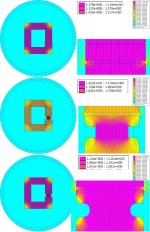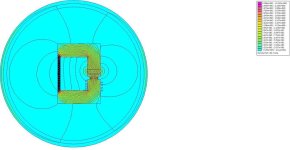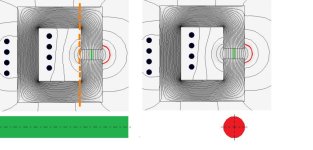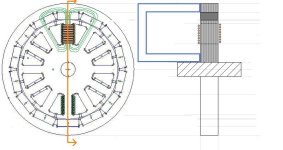Firstly, let me apologise for not getting back to you earlier. I had part written a reply, when a distance memory of something I had read stirred in my brain. It took me a while to to remember where and what, re-read it -- this time trying to understand it -- and then I had to run a bunch of simulations to make sure I'd understood well enough to apply it.
major said:
Again, the core I showed was to illustrate Ampere's Law not to model exactly a portion of a motor.
Understood. I misunderstood your purpose and viewed it in a quite different way to you.
major said:
But in your last diagram the added blue horseshoe best explains it.
I'll get back to that.
major said:
However the 8 conductors on the left side of the tooth are now passing thru the new path and are productive whereas the 8 conductors on the right side of the tooth are outside this magnetic path (core) and are noncontributing end turns (along with portions of wire connecting the 16 conductors shown.
This is where we differ. I see coils wrapped around core, you see them "passing thru". Its a subtle distinction, but one which makes a (IMO) significant difference.
major said:
An analogy is the Gramme ring where 3 of the 4 coil sides are noncontributing (end turns).
I did look that up the first time you mentioned it, and beyond a few photos of some typically impressive Victoriana that didn't show enough detail to understand the principle, I didn't learn much. This time I've persisted longer and now think I get it.
The significant difference I see between that motor and the typical e-bike motors I'm trying to describe, is that the coils wind around the full diameter of the rotor (as most clearly shown in this image:
.
The current flowing in opposite sides of each turn of coil, are on opposite sides of the axis of rotation, thus, when they cut the same magnetic field, the Lorentz force they generate acts to push the rotor down on one side, and up on the other. Ie. it is a true Lorentz force motor.
In the motors I've been describing the Lorentz force on either side of the same tooth are both on the same side of the axis of rotation, and so their equal and opposite nature means they cancel each other out. (They also act on the fixed stator.)
Something else has to be the source of the torque.
major said:
In that last diagram you show a nice depiction of the parallel magnetic paths (in green). Each path crosses the air gap twice hence double air gap reference before. Another reason it is difficult to use a single air gap example. Also to simulate maximum torque the tooth needs to center between two magnets.
Indeed. A single tooth simulation is useless for deriving any realistic metrics about a full motor; it only serves to explore the how the shape affects the flux in and around the tooth, magnet and airgap. Its simplicity allows me to put more detail -- individual conductors, individually modeled laminates etc -- whilst having the models process in relatively short amounts of time.
Now, back to that "blue horseshoe". For me, that horseshoe was simply scaffolding that served on to facilitate modelling an axial plane cross-section of the tooth. It was intended purely as a substitute for the return path that I couldn't show in this 2D representation. It was meant to not otherwise effect the model.
You believe it does, and on further examination you are correct! Though perhaps not quite in the way you think. (Or more correctly, not quite in the way I think, you think

I have a bunch of connected simulations that show this, but I need to clean them up, reduce them and describe them. I'll get to it sometime if you're interested.
Now to the product of that half remembered idea, the research and some results that you might find interesting. It involves a big image. I hope the process of reducing its size so the site will allow me to upload it doesn't degrade the details too much when you view it.
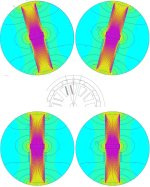
First look at the top two circles, and know they constitute a single simulation.
Then look at the partial axial view of a typical bldc outrunner below and picture that the two teeth in the top circles are radial cross-sections of the two teeth mark with green and blue lines.
(It's stretches credibility because the teeth seem oddly long, they are isolated, and the back-iron above the magnets and below the teeth does not appear to be shown. But bear with me.)
There is a mathematical device called a boundary condition, that allows you to connect two otherwise isolated parts of a simulation.
In the case of the top two circles, the upper hemisphere of the left flux map boundary, is mathematically connected to the upper hemisphere of the right flux map boundary. And ditto for the two lower hemisphere boundaries.
That means that the simulator has connected them mathematically, and the force and direction of any flux crossing the upper left boundary, re-enters into the upper right, and vice versa. Ditto for the bottom boundaries. More importantly,it means that when the solver its iterating its calculations, each side is duly influencing the other as it converges to a solution.
Why bother when you could just connect them with material in the normal way. Because it doesn't just work for boundaries that are in the same 2D plane.
That said, now look at the bottom two circles. They look the same except that they are upright, but they are actually not radial cross-sections of two adjacent teeth, but rather axial cross-sections.
That is to say, they are axial cuts through the stator teeth shown by the green and blue lines. Two sections that would normally be one behind the other in an axial plane view.
Normally, these cannot be modeled at the same time because they are in different 2D planes, but by the trickery of boundary conditions, they can be modeled side by side and connected, without resorting to crude scaffolding as represented by the blue horseshoe in my previous post.
That means that the coils shown in both images are the end turns of those two teeth, and the flux pattern (and the magnetic circuit between them) is correct; and significantly, uninfluenced by any scaffolding structures.
And the really significant part about that (IMO ), is that it shows that whilst there is a lot of fringing evident around the (ends of the) air gap, with the exception of a local loop-back around the ends of the magnets, every single flux line produced by the end turns, flows through the core and crosses the air gap (producing reluctance torque!).
), is that it shows that whilst there is a lot of fringing evident around the (ends of the) air gap, with the exception of a local loop-back around the ends of the magnets, every single flux line produced by the end turns, flows through the core and crosses the air gap (producing reluctance torque!).
Most of those flux lines in the core flow around the full circuit -- crossing out the top of the left map, back in top right, down through the magnet and across the air gap in that tooth, before exiting bottom right and re-entering bottom left.
And those few that exit the ends of the teeth (left and right in this view), circle back and re-enter on the other side (above or below) the air gap.
I really hope you find that as convincing as I do. If not, I guess we'll just have to agree to differ

Notes:
- The reason the teeth are so long, is to allow me to make the bounding circles big enough that they do not influence the flux that circles back locally across the air gap, and so avoids 'corrupting' or compromising the model.
(If it helps, you can think of the extensions to the teeth as my having split the back-iron mid-way between the two teeth and folded it back to put it in the same plane.)
.
- Although I call this a "mathematical trick", it is (so I am assured) a perfectly sound mathematical process, and is effectively the same process (periodic boundary condition) that is used when you see only 1/4 or 1/3rd of a motor simulated.
In that case, the boundary conditions tie the two cut radials of the part motor together, exploiting physical and magnetic symmetries to cut simulation run times
.
.
As I mentioned, I do have some other stuff pertaining to why I make the distinction between the wire coil motor and (what I now think I must call) 'wound-tooth, salient pole BLDC motors' of the type inset above; in order to avoid further alphabetty spaghetti discussions.
But that's for another day

